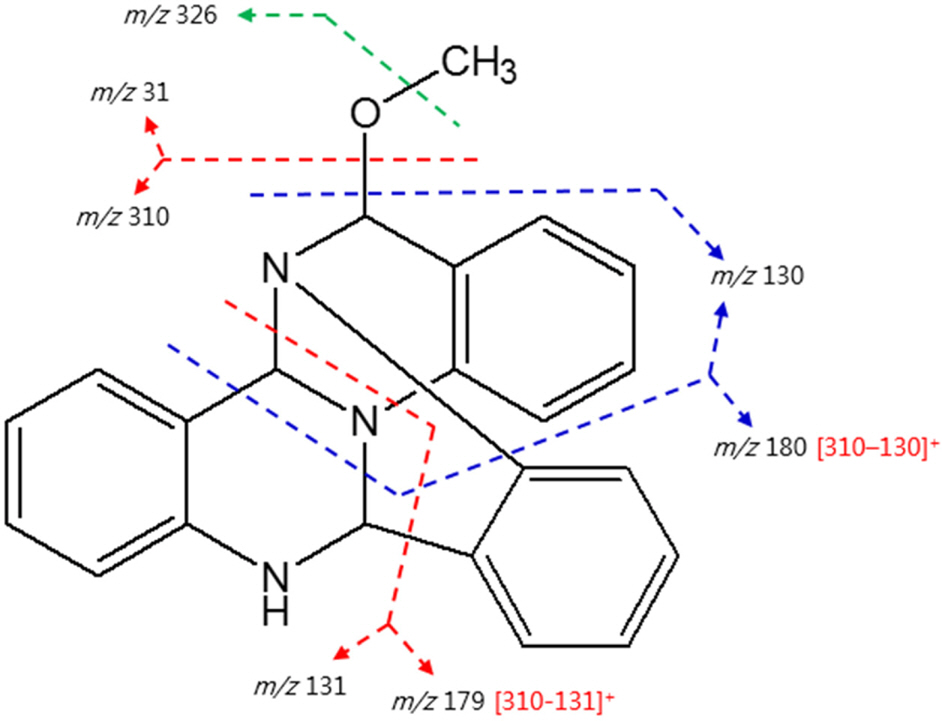Nat Prod Sci.
2016 Sep;22(3):216-219. 10.20307/nps.2016.22.3.216.
New Production of Antibacterial Polycyclic Quinazoline Alkaloid, Thielaviazoline, from Anthranilic Acid by the Marine-Mudflat-Derived Fungus Thielavia sp.
- Affiliations
-
- 1Department of Chemistry, Pukyong National University, Busan 608-737, Korea. sonbw@pknu.ac.kr
- KMID: 2355148
- DOI: http://doi.org/10.20307/nps.2016.22.3.216
Abstract
- The microbial transformation of anthranilic acid (1) by the marine-mudflat-derived fungus Thielavia sp. produced an antibacterial polycyclic quinazoline alkaloid, thielaviazoline (2). The stereostructure of the metabolite was assigned based on detailed spectroscopic data analyses including comparison of the NMR (¹H and ¹³C) data with those of reported compound (2). Compound 2 displayed in vitro antimicrobial activity against methicillin-resistant and multidrug-resistant Staphylococcus aureus (MRSA and MDRSA), with minimum inhibitory concentrations (MICs) of 6.25 and 12.5 µg/mL, respectively. Compound 2 also showed potent radical-scavenging activity against 2,2-diphenyl-1-picrylhydrazyl (DPPH) with an ICâ‚…â‚€ of 11 µM, which was more active than the positive control, L-ascorbic acid (ICâ‚…â‚€, 20.0 µM).
MeSH Terms
Figure
Reference
-
(1). Lee I. -S., ElSohly H. N., Hufford C. D.Pharm. Res. 1990; 7:199–203.
Article(2). El Sayed K. A., Hamann M. T., Waddling C. A., Jensen C., Lee S. K., Dunstan C. A., Pezzuto J. M. J.Org. Chem. 1998; 63:7449–7455.(3). Li X., Lee S. M., Choi H. D., Kang J. S., Son B. W.Chem. Pharm. Bull. 2003; 51:1458–1459.(4). Li X., Kim S. -K., Jung J. H., Kang J. S., Choi H. D., Son B. W.Bull. Korean Chem. Soc. 2005; 26:1889–1890.(5). Li X., Kim Y. H., Jung J. H., Kang J. S., Kim D. -K., Choi H. D., Son B. W.Enz. Microbial Technol. 2007; 40:1188–1192.(6). Leutou A. S., Yang G., Nenkep V. N., Siwe X. N., Feng Z., Khong T. T., Choi H. D., Kang J. S., Son B. W. J.Microbiol. Biotechnol. 2009; 19:1150–1152.(7). Feng Z., Nenkep V., Yun K., Zhang D., Choi H. D., Kang J. S., Son B. W. J.Microbiol. Biotechnol. 2010; 20:985–987.(8). Yun K., Kondempudi C. M., Choi H. D., Kang J. S., Son B. W.Chem. Pharm. Bull. 2011; 59:499–501.(9). Leutou A. S., Yun K., Son B. W.Bull. Korean Chem. Soc. 2014; 35:2870–2872.(10). Yun K., Kondempudi C. M., Leutou A. S., Son B. W.Bull. Korean Chem. Soc. 2015; 36:2391–2393.(11). The Chemical Daily Co. 10, 889 of Chemical Products. The Chemical Daily Co., Ltd.;Japan: 1989. p. 499–500.(12). Li Y., Li X., Son B. W.Nat. Prod. Sci. 2005; 11:136–138.(13). Smith R. V., Rosazza J. P. J.Pharm. Sci. 1975; 64:1737–1759.
Article(14). Manske R. H. F., Holmes H. L.The Alkaloids – Chemistry and Pharmacology. Vol. III; Academic Press: USA. 1953; 101–111.(15). Xiao X., Fanwick P. E., Cushman M.Synth. Commun. 2004; 34:3901–3907.(16). Younes E. A., Hussein A. Q., May M. A., Fronczek F. R.ARKIVOC. 2011; 2:323–330.
- Full Text Links
- Actions
-
Cited
- CITED
-
- Close
- Share
- Similar articles
-
- Graphiumins I and J, New Thiodiketopiperazines from the Marine-derived Fungus Graphium sp. OPMF00224
- Pestalotiolide A, a New Antiviral Phthalide Derivative from a Soft Coral-derived Fungus Pestalotiopsis sp.
- Viridicatol from Marine-derived Fungal Strain Penicillium sp. SF-5295 Exerts Anti-inflammatory Effects through Inhibiting NF-kappaB Signaling Pathway on Lipopolysaccharide-induced RAW264.7 and BV2 Cells
- Calyxaprenols A-D, New Merohexaprenoid Metabolites from the Marine Sponge Calyx sp.
- Xylaroisopimaranin A, a New Isopimarane Derivative from an Endophytic Fungus Xylaralyce sp.



